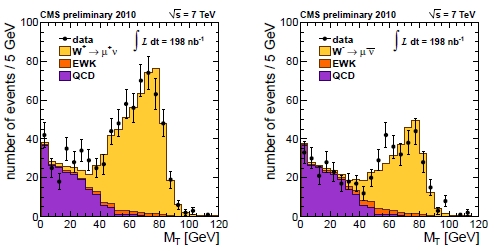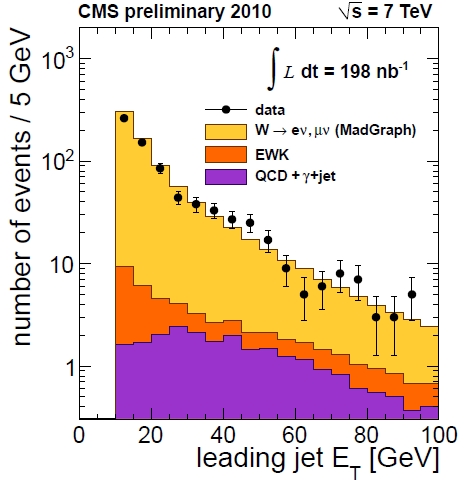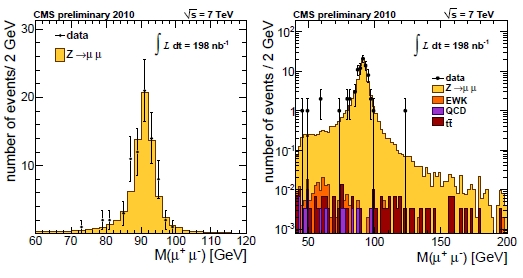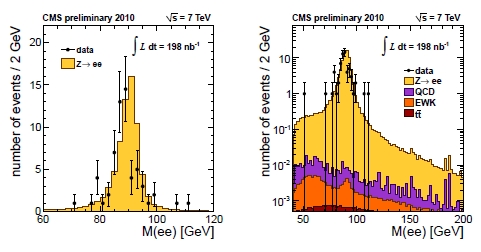Here I wish to assemble some of the electroweak physics results produced by CMS in time for ICHEP. The CMS experiment has shown results that use up to 280 inverse nanobarns of proton-proton collisions, but for electroweak measurements -those involving W and Z signals, to be clear- the statistics used is up to 200 inverse nanobarns of well-understood data.
It is exciting, and quite pleasing, to see how quickly the results have been produced. The speed at which a collaboration goes from raw data on tape to plots for conferences is in my opinion a quite important indicator of the confidence of the collaboration on the whole chain -detector, analysis tools, internal scrutiny. And CMS appears to pass this evaluation with flying colours!
So, W bosons are readily produced in proton-proton collisions, as is clear in the distributions below. These show the transverse mass of muon-neutrino systems, in events where a high-momentum muon has been detected, and where the calorimeter is used to measure the imbalance in the energy flow due to the escaped neutrino.

(If it is not clear to you what a "transverse mass" is, try to figure what would happen if you were to measure the volume of an object built with Lego blocks by just measuring the two widest sides. You would miss the third dimension, so most of the times you would underestimate the volume; your measurement would assume that the "depth" of the object is "one unit" of Lego blocks. However, sometimes you would indeed measure the right value: this would be the case if the object really was built with one single layer of blocks. With W bosons it is the same thing: when the muon and the neutrino happen to be emitted orthogonally to the beam axis (the dimension we ignore, since we do not know the neutrino momentum along the beam direction), we get the true mass; when instead a significant amount of energy is lost along the beam, we measure less of it. This explains the long tail to smaller values of mass.)
From a comparison of the left and the right panel you can see that LHC produces more positive W bosons than negative ones (the W contribution is the yellow histogram in both panels, turning on above 40 GeV of transverse mass). Violation of some basic symmetry rule ?? No, simply the result of the initial state containing more positive-charge quarks than negative-charge ones!
Please also note how clean the W signal is. These distributions will one day allow us to improve the already excellent precision in the mass of the W boson, plus to perform a host of other detailed studies.
One thing we can do already now, however, is to study the energy of jets recoiling against the W boson. This can be seen in the plot attached below: the recoiling jet transverse energy follows closely the predictions of simulations.

And what about Z bosons ? Well, of course they are less frequent -because of the smaller production rate, and because of the smaller branching fraction to electron and muon final states. Still, CMS produced significant signals already with 200 inverse nanobarns of data. Have a look at the dimuon mass, shown both in linear (left) and logarithmic scale (right) in the figure below.

What is significant in the plots is the extremely clean signal these decays provide: backgrounds are totally invisible in a linear scale, and they only appear in the log plot. At the Z mass peak, backgrounds appear to amount to less than a part per mille. Also worth noting is the very good resolution of the detector: the width of the Z boson mass distribution is close to that which the Z naturally has, due to its extremely short lifetime.
A similar signal is visible with electron-positron final states, as shown below:

Again, one notes the extremely clean nature of these events: the QCD background is mostly irrelevant. However, this is an inclusive selection: if one were to look for events with a Z boson and several jets, say, the QCD component would dramatically increase its relative importance. Such considerations will come into play when we search for new physics signals!
With the data shown above, CMS has measured the cross section of W and Z production in electron and muon final states at 7 TeV, as well as the ratio of W over Z production, a number which can be known with better accuracy than the absolute rate, due to the canceling of several systematic uncertainties. You can find all the measurements in the CMS public web pages. Here I will just flash one last figure, which amiably shows the increase of the production rate of vector bosons with the center-of-mass energy of the hadron collision.
Note that the blue lines showing the trend of cross section versus energy are broken: having proton versus antiproton or proton versus proton changes the production mechanisms, and thus the rate cannot be strictly compared with the Tevatron and UA1/2 measurements (on the left).

All in all, a rich bounty of measurements, already with 200 inverse nanobarns of data! I drool at the thought of what we will do with three orders of magnitude more data next year!




Comments